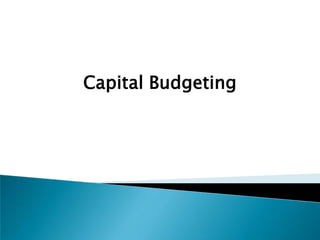
Lecture 9 capital budgeting
- 2. Capital budgeting: Defined as the analysis of investment alternatives involving cash flows received or paid over time. Capital budgeting is used for decisions about replacing equipment, leasing or buying, and plant acquisitions. 3-2
- 3. A euro today is worth more than a euro tomorrow, because you could invest the euro today and have your euro plus interest tomorrow. Value at end Alternative of one year A. Invest €1,000 in bank account earning 5 percent per year €1,050 B. Invest €1,000 in project returning €1,000 in one year €1,000 Alternative B forgoes the €50 of interest that could have been earned from the bank account. 3-3
- 4. Because investment decisions are made at the beginning of the investment period, all future cash flows must be converted to their equivalent value now. Beginning-of-year amount (1 Interest rate) = End-of-year amount Beginning-of-year amount = End-of-year amount (1 Interest rate) 3-4
- 5. FV = Future Value PV = Present Value r = Interest rate per period n = Periods from now Future Value of a single amount: FV = PV (1 + r)n Present Value of a single flow: PV = FV (1 + r)n Discount factor = 1 (1 + r)n 3-5
- 6. Present value of an annuity (a stream of equal periodic payments for a fixed number of years) PV = (PMT r) { 1 – [1 (1 + r)n]} 3-6
- 7. Procedure 1. Identify after-tax cash flows for each period 2. Determine discount rate 3. Multiply by appropriate present-value factor for each cash flow. PV factor is 1.0 for cash invested today. 4. Sum of the present values of cash flows = net present value (NPV) 5. If NPV 0, then accept project 6. If NPV < 0, then reject project NPV is also known as discounted cash flow (DCF). 3-7
- 8. 1. Discount after-tax cash flows, not accounting earnings Cash can be invested and earn interest. Accounting earnings include accruals that estimate future cash flows. 2. Include working capital requirements Consider cash needed for additional inventory and accounts receivable. 3. Include opportunity costs but not sunk costs Sunk costs are not relevant to decisions about future alternatives. 4. Exclude financing costs The firm’s opportunity cost of capital is included in the discount rate. 3-8
- 9. Determine cash flows after taxes: Time Cash flow Beginning of project Cash to acquire assets Future years Depreciation deduction return reduces future tax payments (depreciation tax shield) 3-9
- 10. t = Tax rate (tax refund if negative income) R = Revenue in one year (assume all cash) E = All cash expenses in one year (excludes depreciation) D = Depreciation in one year on income tax return Tax expense for one year: TAX= (R - E - D) t After-tax cash flow for year: ATCF = R - E - Tax = R - E - (R - E - D) t = (R - E)(1 - t) + Dt 3-10
- 11. Methods that consider time value of money: 1. Discounted cash flow (DCF), also known as net present value (NPV) method 2. Internal rate of return (IRR) Methods that do not consider time value of money: 3. Payback method 4. Accounting rate of return on investment (ROI) 3-11
- 12. Payback = the time required until cash inflows from a project equal the initial cash investment. Advantages of payback method: Simple to explain and compute Disadvantages of payback method: Ignores time value of money Ignores cash flows beyond end of payback period 3-12
- 13. Average annual accounting income from project Average annual investment in the project = Return on investment (ROI) Average annual investment = (Initial investment + Salvage value at end) 2 Advantages of ROI method: Simple to explain and compute using financial statements Disadvantages of payback method: Ignores time value of money Accounting income is not equal to cash flow 3-13
- 14. Internal rate of return (IRR) is the interest rate that equates the present value of future cash flows to the cash outflows. By definition: PV = FV (1 + irr)^n Comparison of IRR and DCF/NPV methods Both consider time value of cash flows IRR indicates relative return on investment DCF/NPV indicates magnitude of investment’s return IRR can produce multiple rates of return IRR assumes all cash flows are reinvested at project’s constant IRR DCF/NPV discounts all cash flows with specified discount rate 3-14
- 15. DCF/NPV has become the most commonly used capital budgeting method for evaluating new and replacement projects in business enterprises. 3-15
